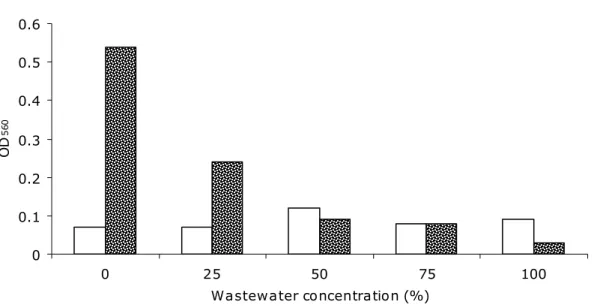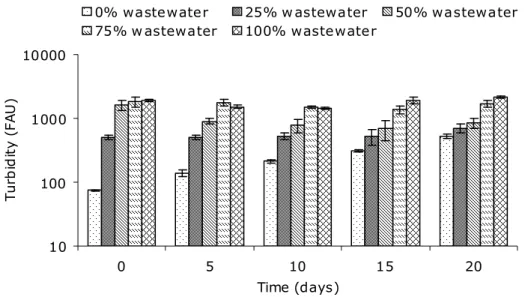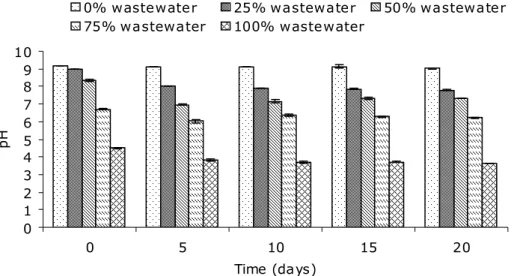ELBA BIOFLUX
Extreme Life, Biospeology & Astrobiology
International Journal of the Bioflux Society
Utilization of
Spirulina platensis
for wastewater
treatment in fermented rice noodle factory
1
Sumontip Bunnag,
2Witaya Pimda, and
2Sirinapa Pongpera
1Applied Taxonomic Research Center (ATRC), Department of Biology, Faculty of Science, Khon Kaen University, Muaeng Khon Kaen, Thailand. 2Department of Biology,
Faculty of Science, Khon Kaen Universiy, Muaeng Khon Kaen, THAILAND. Corresponding author: S. Bunnag, sumbun@kku.ac.th
Abstract. Spirulina platensis is a single-cell blue-green alga which belongs to the family Oscillatoriaceae.
S. platensis can grow in polluted water and it has been widely used to remove excess nitrate-nitrogen
and total phosphorus content in wastewater from noodle factories. This study was aimed to investigate the effect of wastewater on growth of S. platensis and to examine its potential to reduce nitrate-nitrogen and total phosphorus contents in wastewater from fermented rice noodle factory. Twenty five percent-wastewater mixed Zarrouk’s medium gave rise to the highest growth rate of S. platensis. Optical density (OD) of S. platensis culture increased from 0.07±0.04 to 0.24±0.12. Also, the results exhibited the least value of nitrate-nitrogen and total phosphorus contents when performed in 25 % and 100 % wastewater-mixed Zarrouk’s media, respectively.
Key Words: Fermented rice noodle factory, wastewater treatment, nitrate-nitrogen, total phosphorus.
Rezumat. Spirulina platensis este o algă unicelulară albastră-verde care aparţine familiei
Oscillatoriaceae. S. platensis poate creşte în ape poluate şi a fost folosită frecvent pentru îndepartarea
excesului de nitraţi şi a conţinutului de fosfor din apele reziduale de la fabricile de paste făinoase. Acest studiu şi-a propus investigarea efectului apei reziduale asupra creşterii speciei S. platensis şi examinarea potenţialului de reducere a nitraţilor şi a conţinutului de fosfor în apele reziduale provenite de la orezul fermetat din fabricile de paste făinoase. Un procent de 25% de ape reziduale dizolvate în mediul Zarrouk a determinat cea mai ridicată rată de creştere la S. platensis. Densitatea optică a culturii de S. platensis a crescut de la 0.07±0.04 la 0.24±0.12. De asemenea, s-au obţinut valoari scăzute a nitraţilor şi a conţinutului de fosfor când amestecul de ape reziduale dizolvate în mediul Zarrouk a fost crescut de la 25% la 100%.
Cuvinte cheie: fabrică de paste făinoase din orez fermentat, ape reziduale, nitraţi, fosfor total.
Introduction. Fermented rice noodle is favorable food for Thai people. A process for
producing the fermented rice noodle requires a great deal of water, thus resulting in high volume of wastewater. A fermented rice noodle factory is a source of undesirable smell and litter, and directly affects sanitation and low quality of wastewater. In order to exist in the community, the factory must hold wastewater treatment systems before discharge into water resources. Organic-rich wastewater from the factory can be as a nutrient source for microalgae. During photosynthesis, the microalgae utilize nitrogen and phosphorus together with releasing oxygen into water resources. Falmer (1969) and Bunsom (1987) found that Spirulina sp. and Chlorella sp. can survive in wastewater and help reduce excess nutrients e.g. nitrogen and phosphorus in water resources, thus improving water quality (Phoathongsuk 2000). We, therefore, used Spirulina sp. and
Chlorella sp. to better the quality of wastewater by reducing nitrate-nitrogen and total phosphorus in the fermented rice noodle factory.
Material and Method. Wastewater from the fermented rice noodle factory was
evaluated for nitrate-nitrogen, total phosphorus, turbidity, total dissolved solid and conductivity prior to each study.
Spirulina platensis was cultured in Zarrouk’s medium (Zarrouk 1996) and kept for 20 d at 25°C under light intensity of 2 000 lux with nonstop oxygen flow. Optical density (OD) was measured using spectrophotometer at wavelength of 560 nm. Then, S. platensis solution was cultured in wastewater concentrations of 0-100%, 10 ml for each. Each treatment was repeated 4 times.
Experiment II. Nitrate-nitrogen- and total phosphorus-reducing potential of S. platensis
Nitrate-nitrogen was evaluated using the Method 8171, Cadmium Reduction Method while total phosphorus was assessed using the Method 8048, PhosVer3 Ascorbic Acid Method.
Experiment III. Changes in turbidity, total dissolved solid, pH and conductivity of wastewater after algal culture
After algal culture, turbidity was evaluated using the Method 8237--Attenuated radiation (DR 2010 Spectrophotometer), total dissolved solid was measured using the Method 8006—Photometric Method (DR 2010 Spectrophotometer), and pH and conductivity were assessed using InoLab® Multi 720.
Results and Discussion. S. platensis could grow well in all concentrations of
wastewater. However, a significant difference of algal growth was found when varied concentrations were applied. Wastewater concentration of 25% gave rise to the best growth rate. Characteristics of S. platensis cultured under different conditions were shown in Figure 1.
Figure 1. Characteristics of S. platensis when cultured in varied concentrations of wastewater: a) 0%, b) 25%, c) 50%, d) 75% and e) 100%.
The OD increased from 0.07±0.01 to 0.24±0.12 and from 0.11±0.03 to 0.41±0.10, respectively (Figure 2). This finding was consistent to Weerapattanapong (1998) reporting that better growth rate was observed when culture time was prolonged. Bacteria play a role in degrading nutrients in wastewater and converted those nutrients into nitrogen compounds and carbon dioxide which were later utilized in metabolic pathway. Gonzalez & Bashan (2000) reported that the bacterium Azospirillum brasilense
helps improve algal growth. When Batch (close) system was introduced for algal culture, algal growth in the first 5 days was in Lag phase. In this phase, algae adjusted
a b c
d e
they enter Exponential phase in the second week, algae initiate cell multiplication which leads to high growth rate exhibiting dark green color during culture (Vorawut 2004).
S. platensis was capable of best reducing nitrate-nitrogen when cultured in 25% wastewater (Figure 3a). Nitrate-nitrogen content dropped from 16.00±4.30 mg/l to 5.50±1.50 mg/l. Reduction of nitrate-nitrogen was resulted from the fact that nitrogen is essential nutrients for algal growth. When culture time was extended, algae require nitrogen for growth. Due to the fact that S. platensis cannot fix atmospheric nitrogen, abundant nitrogen source in wastewater is alternatively utilized in both organic and inorganic forms. Consequently, extended culture time resulted in reduction of nitrate-nitrogen (Thongtong 1986).
0 0.1 0.2 0.3 0.4 0.5 0.6
0 25 50 75 100 Wastewater concentration (%)
O
D
56
0
Before culture After culture
Figure 2. Growth rate of S. platensis when cultured in varied concentrations of wastewater
Total phosphorus-degrading potential of S. platensis was significantly different in varied concentrations of wastewater (Figure 3b). S. platensis could best reduce total phosphorus in 100% wastewater. Total phosphorus content dropped from 19.50±2.77 mg/l to 5.8±0.64 mg/l. This finding was consistent to Tam & Wong (1989) reporting that
Spirulina sp. could reduce total phosphorus when culture time was increased.
0 5 10 15 20
0 5 10 15 20
Time (days)
N
O
3
-N
(
m
g/
l)
0 5 10 15 20 25
0 5 10 15 20 Time (days)
To
ta
l P
(
m
g/
l)
a b
Values of turbidity, total dissolved solid, pH and conductivity in wastewater which are acceptable for discharge into water resources were found in 25% wastewater-mixture medium.
Turbidity was resulted from total amounts of suspension in water which hinder the journey of light toward water body to reach the bottom of the water resources by reflecting or absorbing light. It was found that turbidity was increased after algal culture. This could be simply explained by the theory of absorption and scattering of light. Light is reflected and absorbed when light travels through algae because algae are microorganisms, thus acting as small particles suspending in water. This resulted in an increase in water turbidity. Figure 4 represented the augumentation of water turbidity in algal culture for 20 days. It was clear that, among all treatments except control, 25% wastewater gave rise to very little increase in water turbidity.
10 100 1000 10000
0 5 10 15 20 Time (days)
Tu
rb
id
ity
(
FA
U
)
0% wastewater 25% w astewater 50% wastewater 75% w astewater 100% wastewater
Figure 4. Turbidity of wastewater after algal culture for 20 days
Total dissolved solids meased in the form of total suspended solids (TSS) also hindered the journey of light toward water body, thus resulting in low photosynthetic capacity of aquatic plants. This phenomenon adversely lowered amounts of dissolved oxyen in water resources. It was certain that 25% wastewater caused little increment of total dissolved solids (Figure 5).
10 100 1000 10000
0 5 10 15 20
Time (days)
To
ta
l
di
ss
ol
ve
d
so
lid
(m
g/
l)
0% wastewater 25% wastewater 50% wastewater
In general, many kinds of algae inhabit in different pH environmenrs. Wastewater should have optimum pH for not harming aquatic lives. The pH of surface water that is safe for the enviroments ranges from 5 to 9 ratified by the Office of the National Environment Board, Thailand (1994). The results showed that S. platensis could grow under wastewater concentrations of 0-75%, pH of 5-9 (Figure 6). The pH values were in in the benchmark of natural water quality (Office of the National Environmental Board, Thailand 1994).
0 1 2 3 4 5 6 7 8 9 10
0 5 10 15 20 Time (days)
pH
0% wastewater 25% wastewater 50% wastewater 75% wastewater 100% wastewater
Figure 6. pH of wastewater after algal culture for 20 days
High conductivity value implied that water was of high salinity. Many kinds of algae could not toterate salt stress except hypersaline algae. Conductivity value represented amounts of nutrient concentrations or total dissolved solids (TDS). Natural water resources should exhibit not exceed 5 mS/cm. Here, the results showed that water conductivity remained stable (Figure 7). S. platensis grew well under high salinity as it could stand hypersaline environments. According to OD560 value, 25% wastewater was considered suitable for S. platensis culture as it exhibited the conductivity in the benchmark of natural water quality (Office of the National Environmental Board, Thailand 1994).
1 10 100
0 5 10 15 20
Time (days)
C
on
du
ct
ivi
ty
(m
S
/c
m
)
0% wastewater 25% wastewater 50% wastewater
75% wastewater 100% wastewater
Acknowlegdement. This work was supported by the Applied Taxonomic Research Center, Khon Kaen University.
References
Bunsom C., 1987 Freshwater algae. Journal of Fishery and Aquatic Science 40 (4):429-431.
Falmer C. M., Washington D. C., 1969 Algae in water supplies: Department of Health. Edreation and Welfare Public Heath service.
Gonzalez L. E., Bashan Y., 2000 Increased growth of the Microalga Chlorella vulgaris
when coimmobilized and cocultured in alginate beads with the plant growth promoting bacterium Azospirillum brasilense. Applied and Environmental Microbiology 66(4):1527-1531.
Office of the National Environmental Board, Thailand., 1994 Available Source: http://www.onep.go.th/neb/1.%20About_neb/webpage/about_neb.html.
Phoathongsuk S., 2000 Research and development potential for algal utilization in Thailand. Srisiam Printing Press, Bangkok.
Tam J. P., Wong F., 1989 Wastewater nutrient removal by Chlorella pyrenidosa and
Scenedesmus sp. Water Science and Technology 30(6):369-374.
Thongtong T., 1986 Nitrogen and phosphorus reduction from community wastewater by algae. M.Sc. thesis, Kasetsart University.
Vorawut K., 2004 The efficiency of Spirulina platensis to reduce BOD, nitrogen and phosphorus in wastewater in sugarcane factory. M.Sc. thesis, Khon Kaen University. Weerapattanapong W., 1998 Nutrients reduction from poultry wastewater by green
algae: Chlorella spp. M.Sc. thesis, Mahidol University.
Zarrouk C., 1996 Contribution à l’étude d’une cyanophycée. Influence de divers facteurs physiques et chimiques sur la croissance et la photosynthèse de Spirulina maxima. Ph.D. thesis, Université de Paris.
Received: 15 July 2010. Accepted: 18 September 2010. Published online: 14 October 2010. Authors:
Sumontip Bunnag, Khon Kaen University, Applied Taxonomic Research Center, Department of Biology, Thailand, Khonkaen, Friendship Highway, 123/2001, 40002, e-mail: sumbun@kku.ac.th
Witaya Pimda, Khon Kaen University, Department of Biology, Thailand, Khonkaen, Friendship Highway, 123/2001, 40002, e-mail: wp_sc29th@hotmail.com
Sirinapa Pongpera, Khon Kaen University, Department of Biology, Thailand, Khonkaen, Friendship Highway, 123/2001, 40002, e-mail: biofunny@hotmail.com
How to cite this article:



